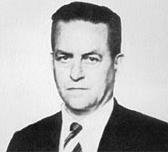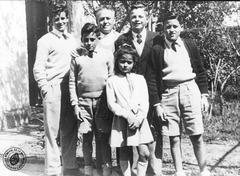
Raúl Scalabrini Ortiz Buenos Aires Visiting Hours, Tickets, and Travel Guide
Date: 15/06/2025
Introduction to Raúl Scalabrini Ortiz in Buenos Aires
Raúl Scalabrini Ortiz stands as a monumental figure in Argentina’s intellectual and cultural history. Renowned for his sharp critique of foreign influence, fierce advocacy for national identity, and a pioneering role in historical revisionism, Scalabrini Ortiz’s legacy is deeply woven into the fabric of Buenos Aires. Landmarks such as Avenida Raúl Scalabrini Ortiz and the National Railway Museum named in his honor invite visitors to connect with his vision and Argentina’s intricate past. This guide is designed for travelers and history enthusiasts alike, offering detailed insights into these emblematic Buenos Aires sites, their historical and cultural significance, practical visitor information, and expert tips for an immersive experience (Raúl Scalabrini Ortiz - Wikipedia, Buenos Aires Tourism).
Table of Contents
- Introduction to Raúl Scalabrini Ortiz
- Early Life and Education
- Intellectual Formation and Political Awakening
- Major Works and Historical Revisionism
- Political Engagement and FORJA
- Journalism and Public Influence
- Legacy and Buenos Aires Historical Sites
- Key Themes and Principles
- Practical Guide: Visiting Hours, Tickets, and Travel Tips
- Frequently Asked Questions (FAQ)
- Final Years and Recognition
- Conclusion and Call to Action
- References and Further Reading
Early Life and Education
Raúl Scalabrini Ortiz was born on February 14, 1898, in Corrientes, Argentina, to a family with a strong intellectual pedigree—his father, Pedro Scalabrini, was a noted naturalist and museum director. Raised in Buenos Aires, Scalabrini Ortiz pursued studies at the Faculty of Exact Sciences, qualifying as a land surveyor and engineer (Raúl Scalabrini Ortiz - Wikipedia, Encyclopedia.com). Despite his technical background, his passion was firmly rooted in literature, history, and the analysis of Argentina’s socio-economic structures. In his early twenties, he became active in Buenos Aires’ literary circles, publishing his first short story collection, La Manga (1923), and engaging in debates that shaped his intellectual trajectory.
Intellectual Formation and Political Awakening
Scalabrini Ortiz’s worldview was shaped by exposure to both Argentine and international ideologies. Early involvement with the Marxist group Insurrexit and extensive travels across Argentina helped him gain an intimate understanding of the country’s regional diversity (Raúl Scalabrini Ortiz - Wikipedia). A pivotal trip to Paris at age 26 confronted him with European xenophobia, solidifying his commitment to Argentine identity. The economic turmoil of the 1930s, including the Great Depression and the 1930 coup, further influenced his critique of liberal economics and foreign—particularly British—domination (Editorial Corprens).
Major Works and Historical Revisionism
Scalabrini Ortiz was a leading voice in Argentine historical revisionism, challenging dominant liberal narratives and highlighting national identity and popular struggles. Key works include:
- El hombre que está solo y espera (1931): An exploration of Argentine identity and the “spirit of the land” (Encyclopedia.com).
- Política británica en el Río de la Plata (1936): A penetrating analysis of British influence and economic dependency in Argentina (Editorial Corprens).
- Historia de los ferrocarriles argentinos (1940): A detailed study of Argentina’s railway development and the impact of foreign interests (Encyclopedia.com).
His alliances with intellectuals like Arturo Jauretche helped shape a nationalist, anti-imperialist perspective that deeply influenced later generations (Raúl Scalabrini Ortiz - Wikipedia).
Political Engagement and FORJA
In 1935, Scalabrini Ortiz co-founded FORJA (Fuerza de Orientación Radical de la Joven Argentina), a dissident movement within the Radical Civic Union. FORJA advocated for nationalist and popular reforms, opposing foreign dependency and supporting economic sovereignty (Raúl Scalabrini Ortiz - Wikipedia, Editorial Corprens). The group’s influence extended into the rise of Peronism and shaped much of Argentina’s mid-20th-century political landscape.
Journalism and Public Influence
Scalabrini Ortiz was a prolific journalist, contributing to major newspapers such as La Nación, El Mundo, and Noticias Gráficas. He also founded Reconquista, a newspaper that provided a platform for his incisive critiques (Raúl Scalabrini Ortiz - Wikipedia). His style—a blend of analytical depth and poetic sensibility—earned him the moniker “poet of politics” and allowed him to reach a broad audience (El Cohete a la Luna).
Legacy and Buenos Aires Historical Sites
Avenida Raúl Scalabrini Ortiz
Avenida Raúl Scalabrini Ortiz runs through the Villa Crespo and Palermo neighborhoods, reflecting both the working-class roots and cosmopolitan vibrancy of the city (Trek Zone). The avenue’s evolution—from a dirt road to a key urban artery—mirrors Argentina’s political and social transformations (Wikipedia, Palermonline). Today, it is a hub for shopping, dining, and cultural exploration.
Key Features:
- Textile and leather outlets in Villa Crespo
- Trendy boutiques and street art in Palermo Soho
- Architectural landmarks and parks near Palermo’s eastern end
- Excellent public transport links via Subte (Line B and Line D) and numerous bus routes (Subte Buenos Aires)
Raúl Scalabrini Ortiz National Railway Museum
Honoring Scalabrini Ortiz’s advocacy for railway nationalization, the museum in Retiro preserves Argentina’s railway heritage (Buenos Aires Tourism). Its collection features:
- The “PATRIA” steam locomotive (1896)
- British-built Hunslet engine (1919)
- The presidential carriage used during Pope John Paul II’s visit (1982)
- Artifacts like ticket machines, clocks, telegraphs, and the desk where railway nationalization was signed (Museo Nacional Ferroviario)
Visitor Information:
- Hours: Daily, 10:00–20:00
- Tickets: Free admission, no booking required
- Accessibility: Wheelchair accessible, with ramps and elevators
- Tours: Guided tours in Spanish, English, and Portuguese; virtual tours available
Key Themes and Principles
Scalabrini Ortiz’s enduring legacy centers on:
- National Identity: Advocating for an authentic Argentine identity distinct from foreign models (Encyclopedia.com)
- Economic Sovereignty: Promoting national control over resources and infrastructure (Editorial Corprens)
- Historical Revisionism: Reinterpreting national history to highlight the struggles and contributions of ordinary Argentines (Raúl Scalabrini Ortiz - Wikipedia)
- Popular Engagement: Empowering citizens through education and political participation
Practical Guide: Visiting Hours, Tickets, and Travel Tips
Avenida Raúl Scalabrini Ortiz
- No tickets required; public avenue open 24/7
- Shops: 10:00–20:00 (weekdays), later on weekends in Palermo
- Markets: Mercado Bonpland open daily; Plaza Güemes organic market on Saturdays 9:00–15:00
- Parks: Parque Las Heras (6:00–21:00), Parque Tres de Febrero (7:00–20:00)
- Transport: Subte Line B (Malabia Station), Line D (Scalabrini Ortiz Station), multiple bus routes (Subte Buenos Aires)
- Accessibility: Wide sidewalks, bike lanes, and many accessible facilities
Raúl Scalabrini Ortiz National Railway Museum
- Hours: 10:00–20:00 daily
- Tickets: Free entry, no advance booking
- Location: Retiro neighborhood; easy access by train, subway, or bus (Turismo Buenos Aires)
- Accessibility: Wheelchair accessible
- Guided Tours: Included in admission; check languages and times at the entrance
Frequently Asked Questions (FAQ)
Q: What are the visiting hours for the National Railway Museum?
A: 10:00–20:00 daily; closed only on select national holidays.
Q: Is there an admission fee for the museum?
A: No, admission is free (Museo Nacional Ferroviario).
Q: Do I need tickets to walk Avenida Raúl Scalabrini Ortiz?
A: No, it is a public thoroughfare.
Q: How do I get to the avenue or museum by public transit?
A: Use Subte Line B (Malabia) or Line D (Scalabrini Ortiz) for the avenue; Retiro Station for the museum.
Q: Are guided tours available?
A: Yes, the museum offers free guided tours in several languages.
Q: Is the area accessible for people with disabilities?
A: Both the avenue (in most sections) and the museum are wheelchair accessible.
Final Years and Recognition
Despite periods of hardship—including unemployment in his later years—Scalabrini Ortiz’s intellectual legacy endures. He continued working as a surveyor until his death in Buenos Aires on May 30, 1959 (Raúl Scalabrini Ortiz - Wikipedia). His writings remain widely studied, and his influence is commemorated through documentaries and the preservation of his namesake sites (El Cohete a la Luna).
Conclusion and Call to Action
Exploring Raúl Scalabrini Ortiz’s legacy in Buenos Aires offers a unique window into Argentina’s national narrative and urban culture. Whether strolling along the avenue, shopping in Villa Crespo, exploring Palermo’s art scene, or delving into railway history at the museum, visitors gain an enriched understanding of Argentina’s past and present. For curated tours, up-to-date information, and deeper insights, download the Audiala app and follow our digital channels.
Ready to experience Buenos Aires like a local? Start your journey now and let the city’s history inspire you!
References and Further Reading
- Raúl Scalabrini Ortiz - Wikipedia
- Encyclopedia.com
- Editorial Corprens
- Buenos Aires Tourism
- Palermonline
- Trek Zone
- El Cohete a la Luna
- Museo Nacional Ferroviario
- Turismo Buenos Aires
- Wikipedia - Avenida Scalabrini Ortiz
- Subte Buenos Aires































































































































































